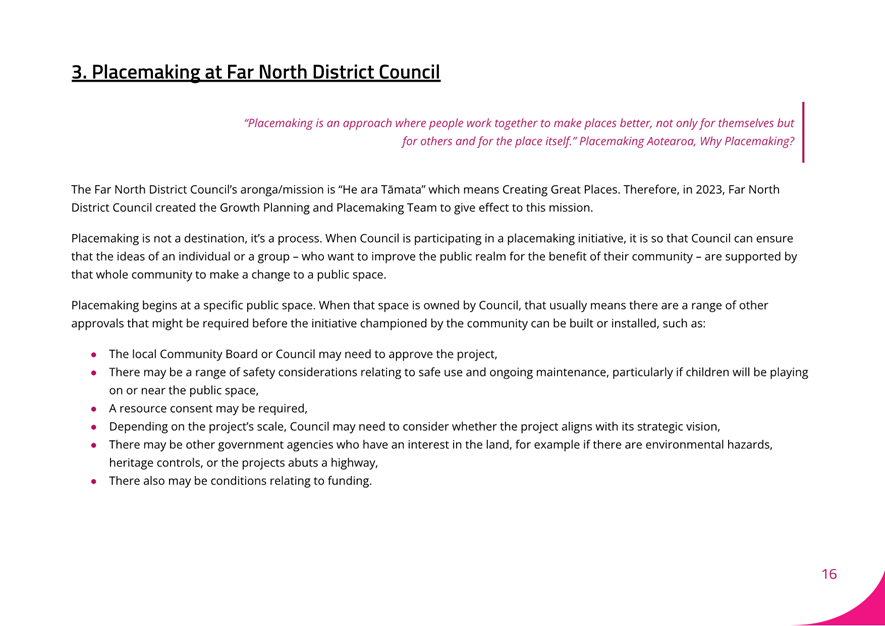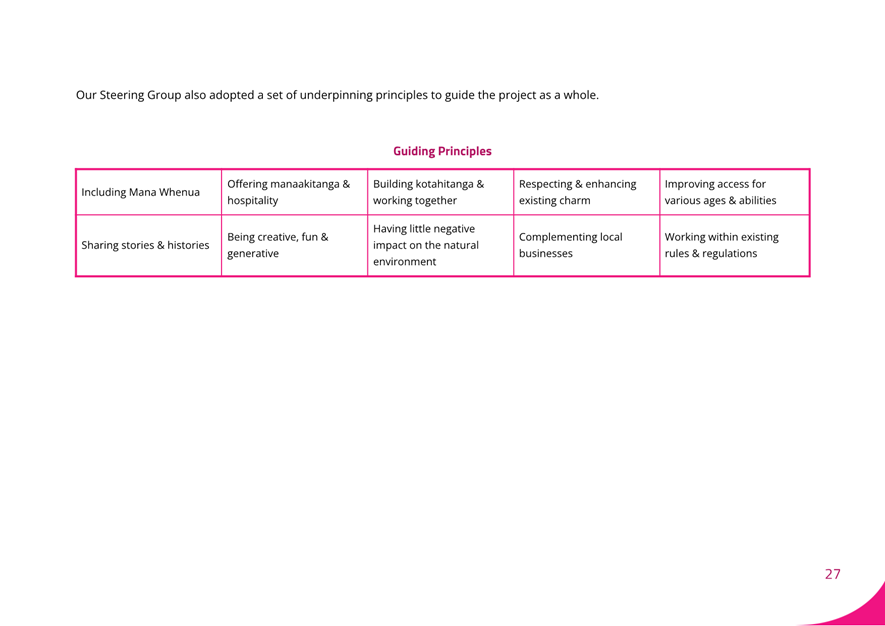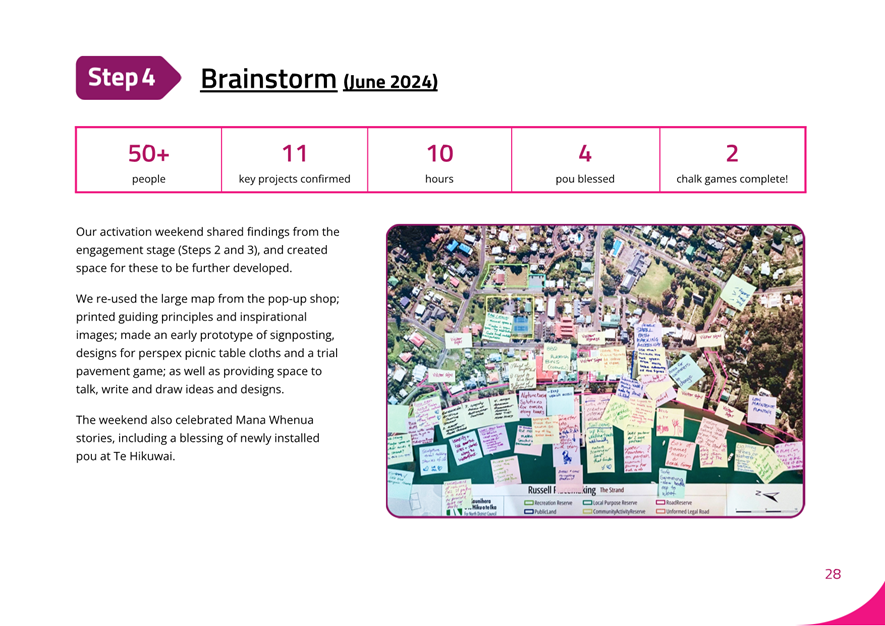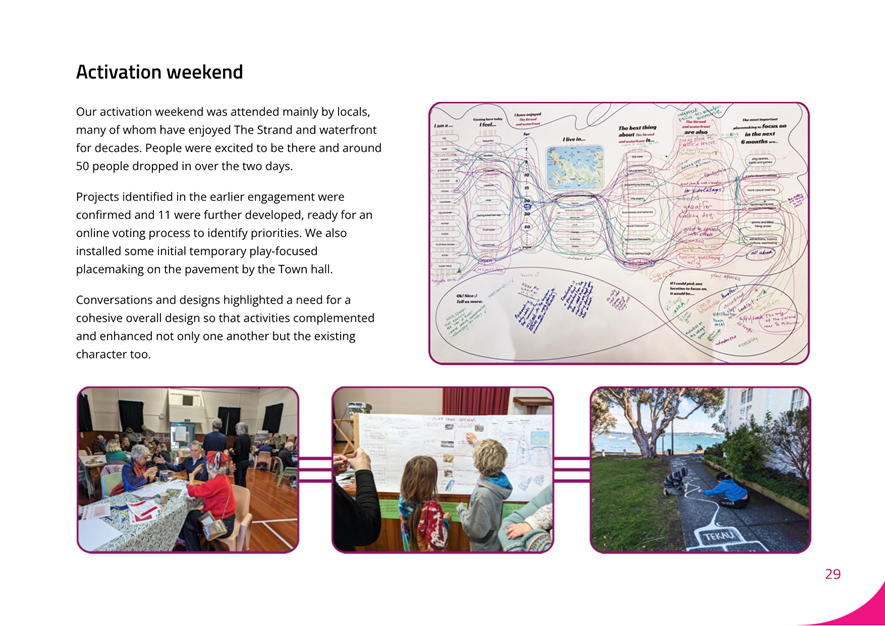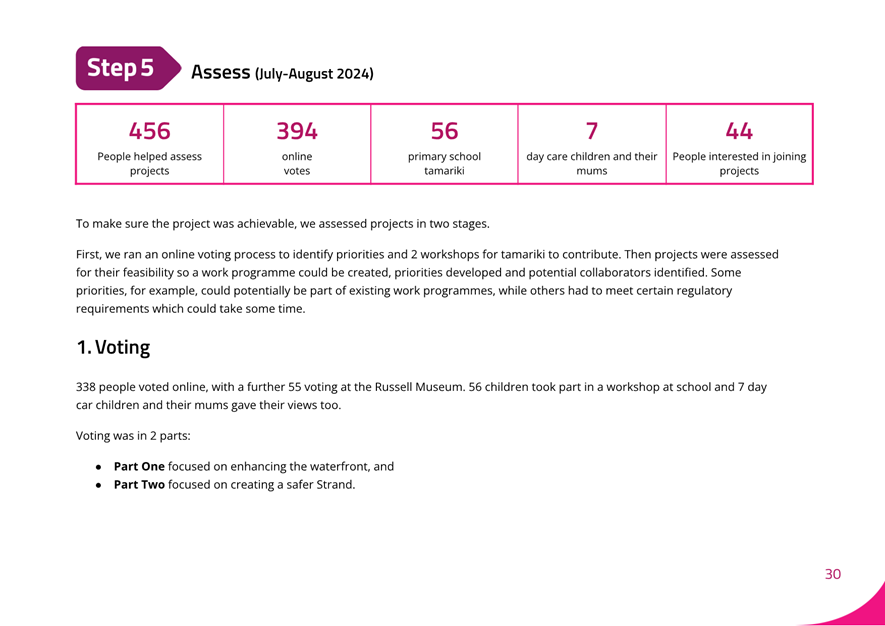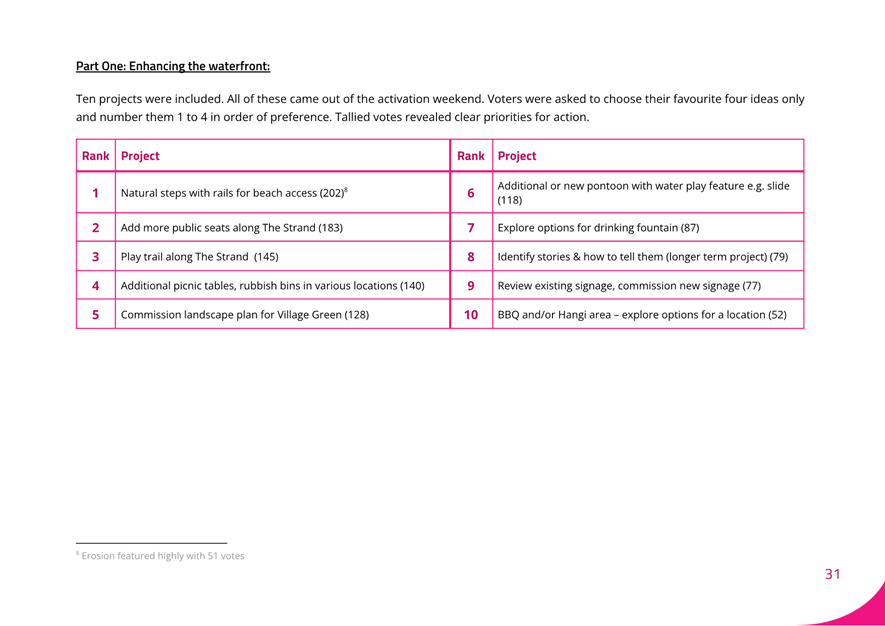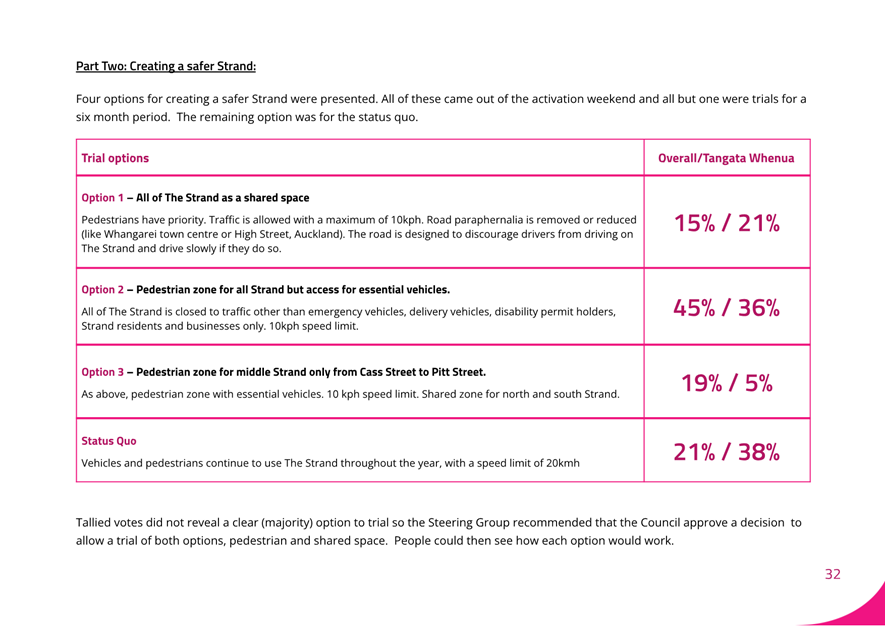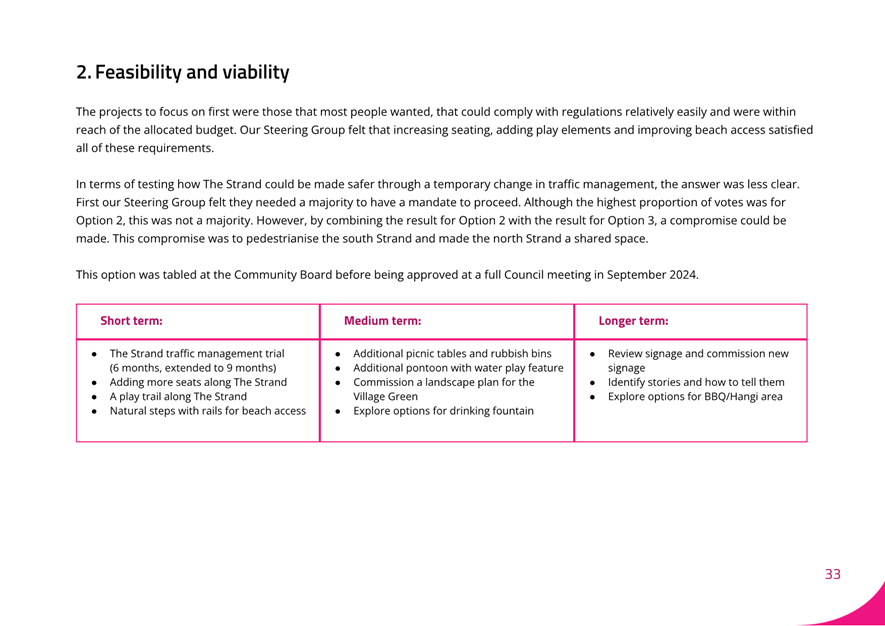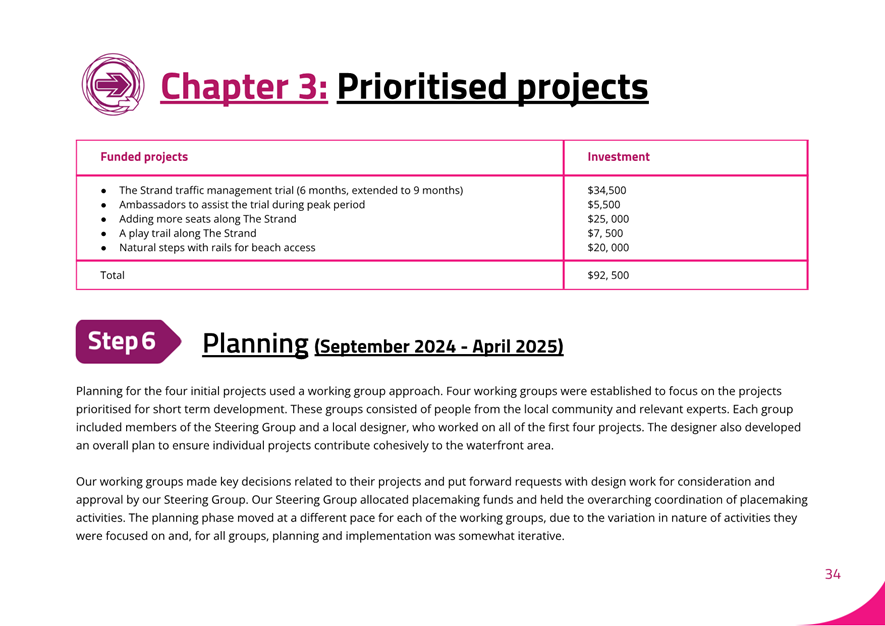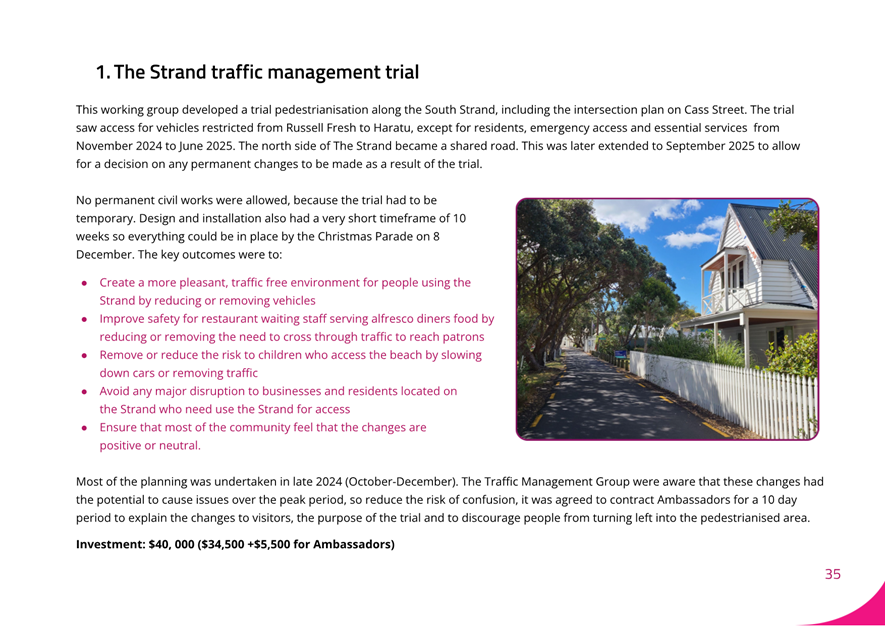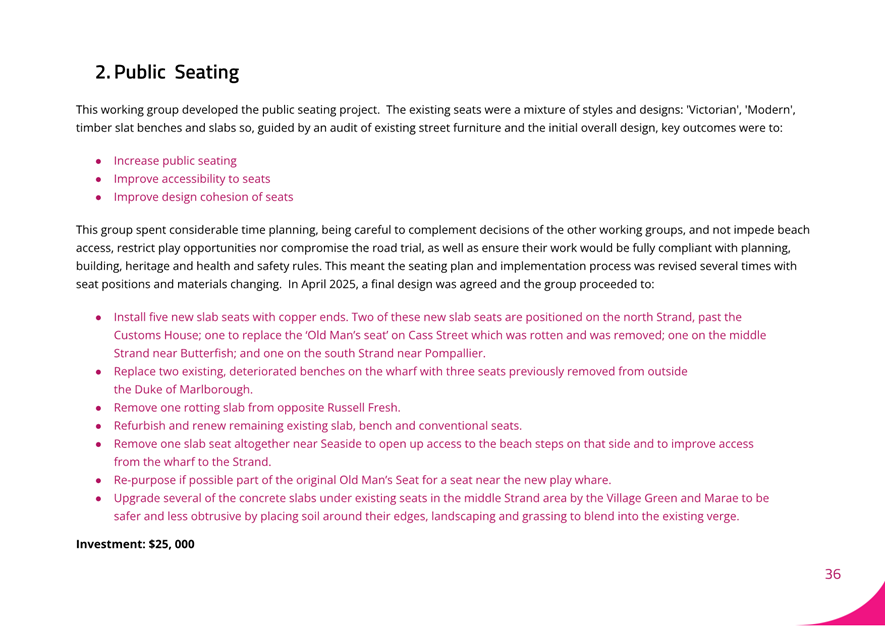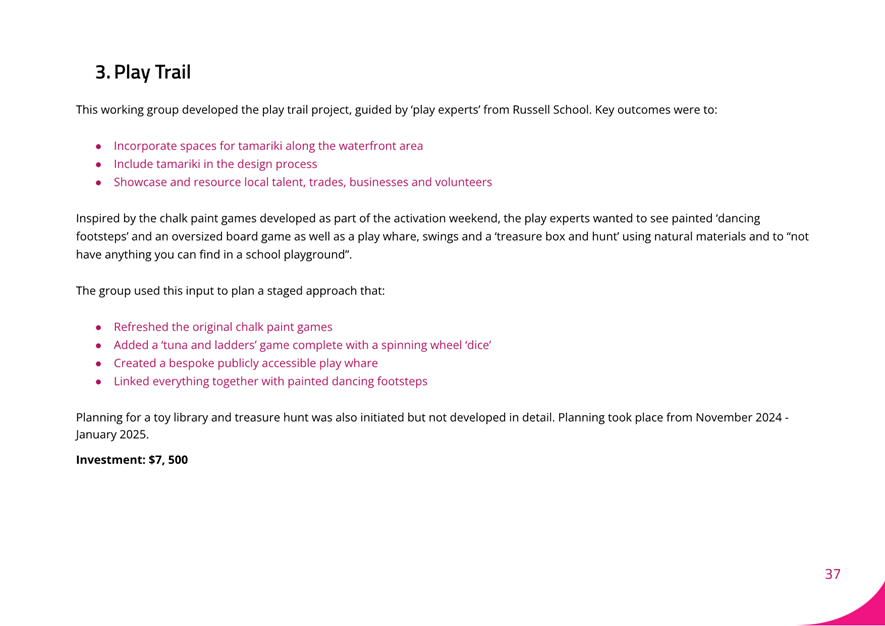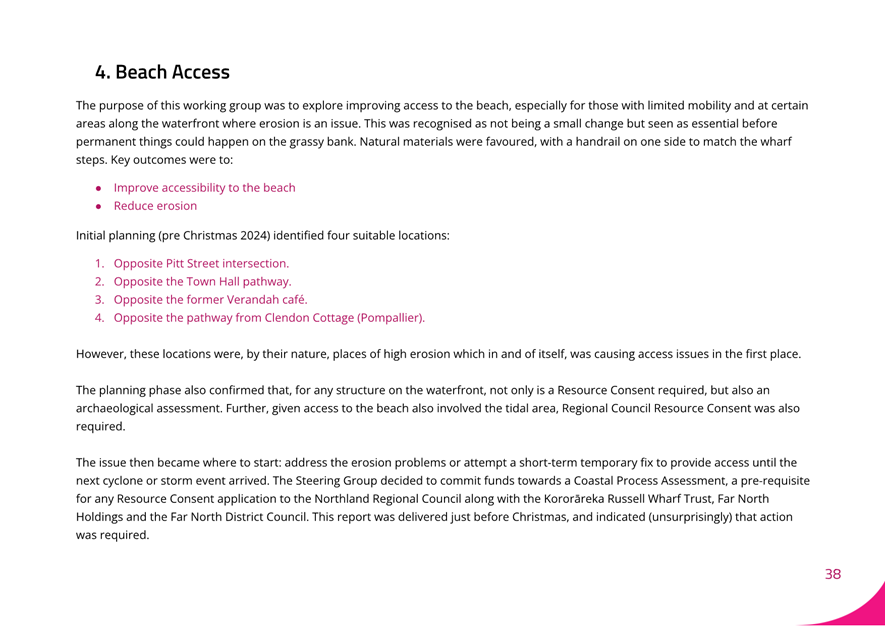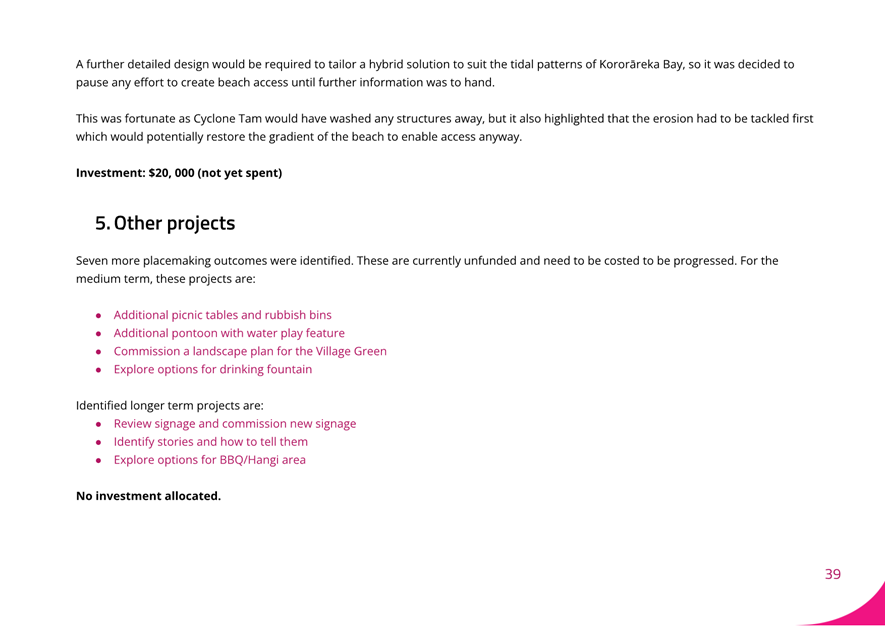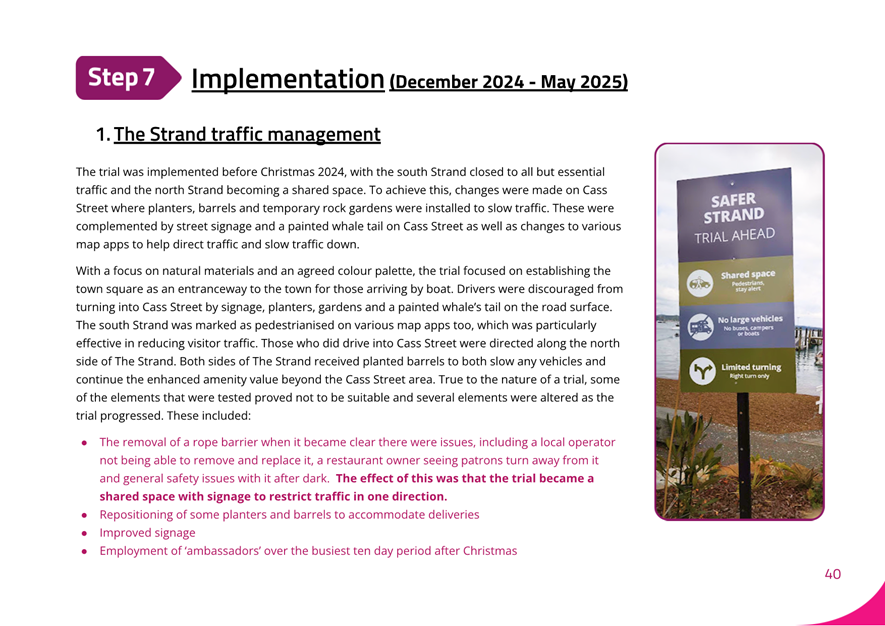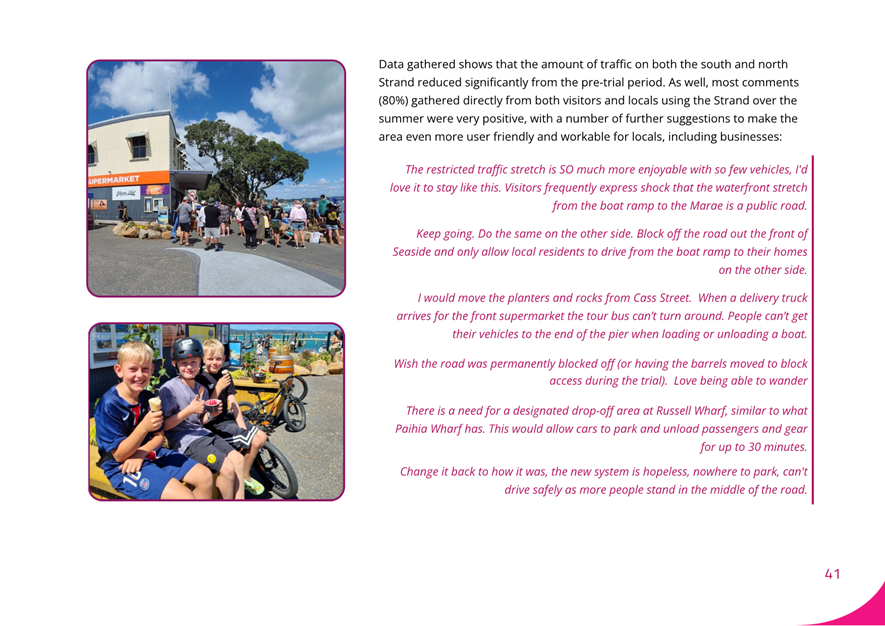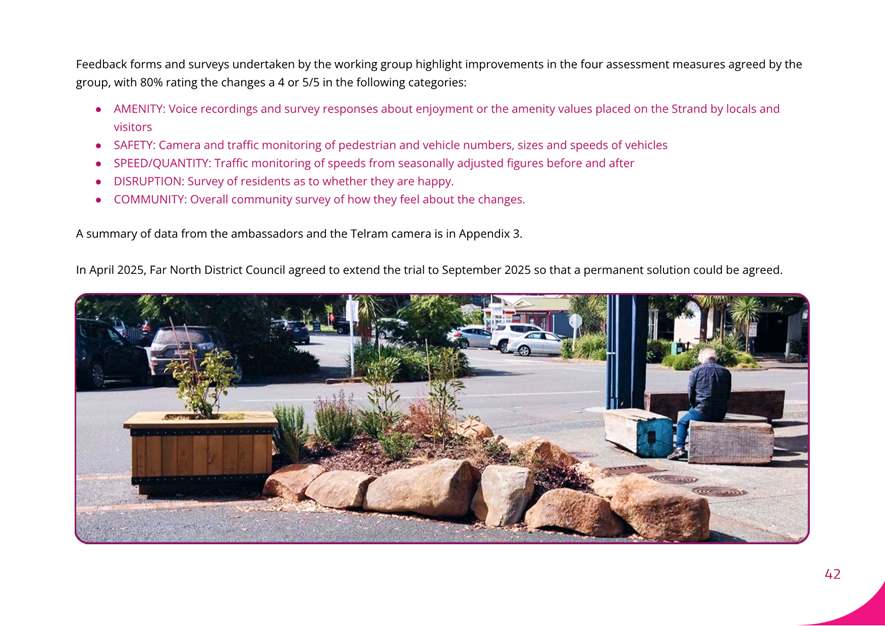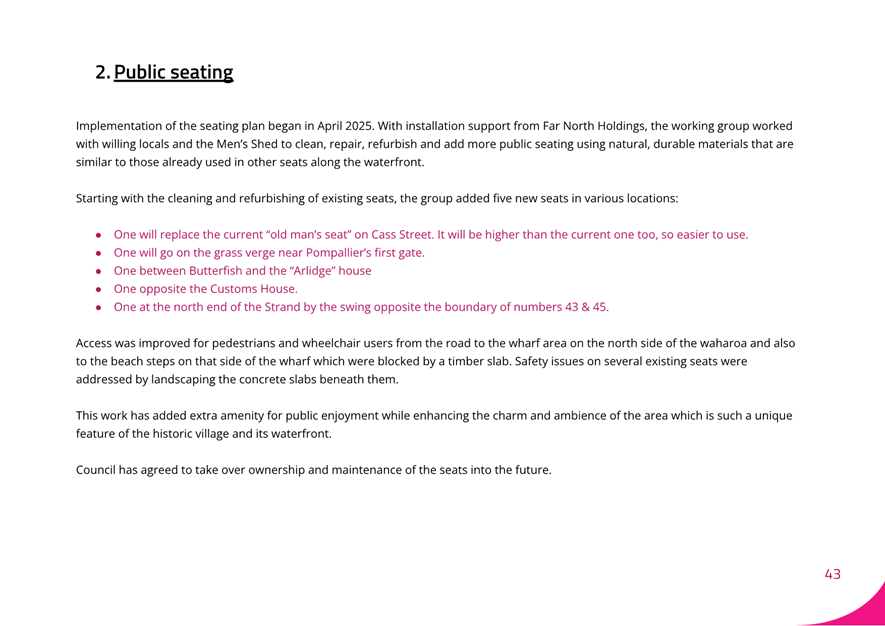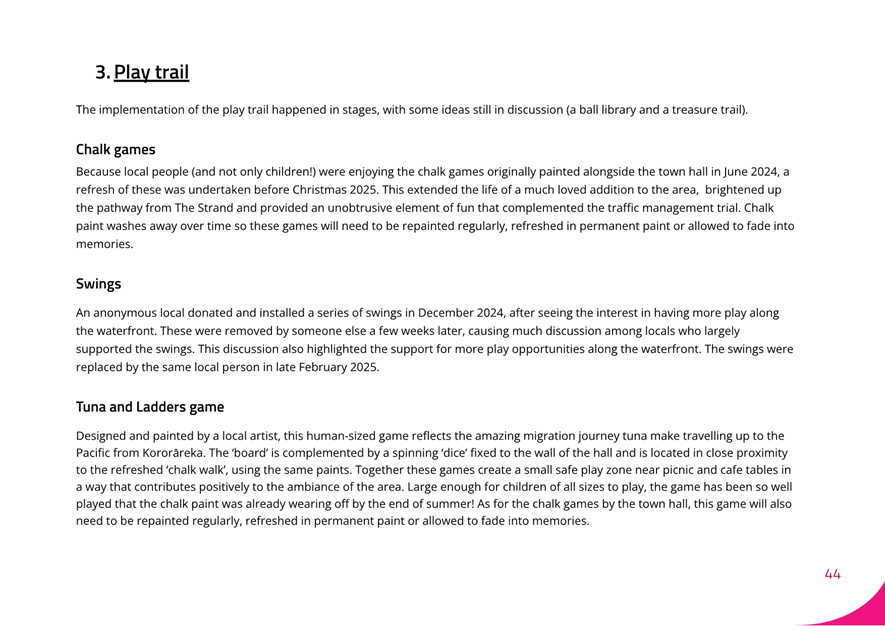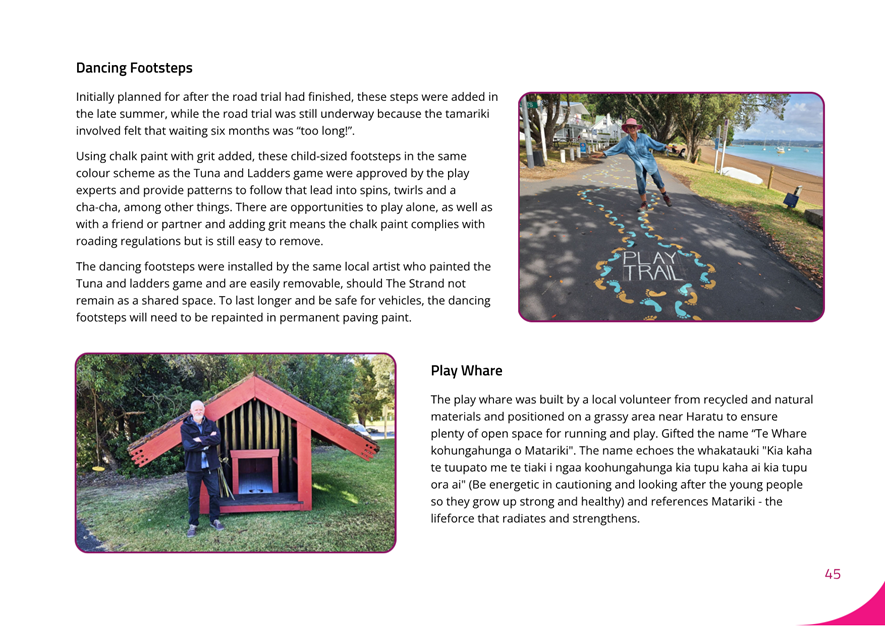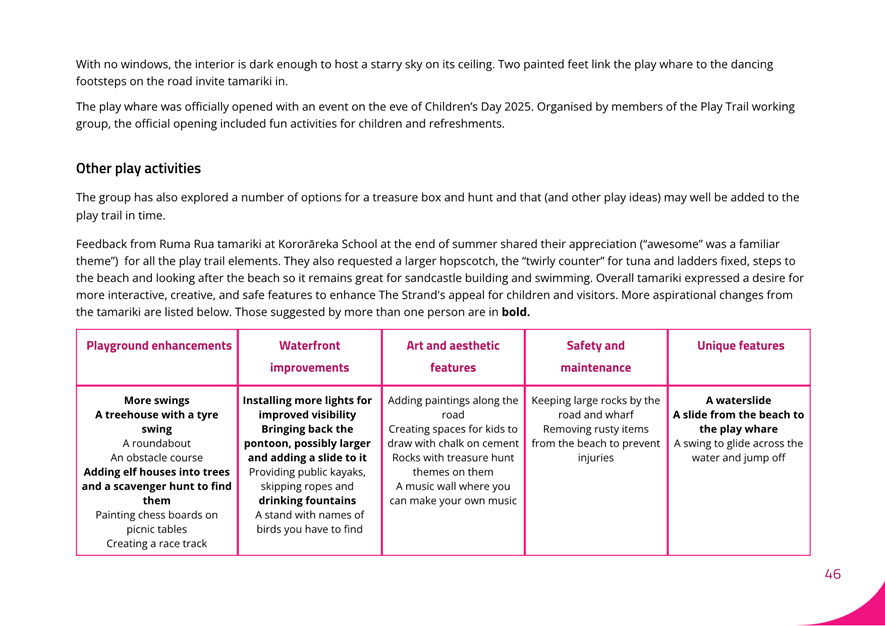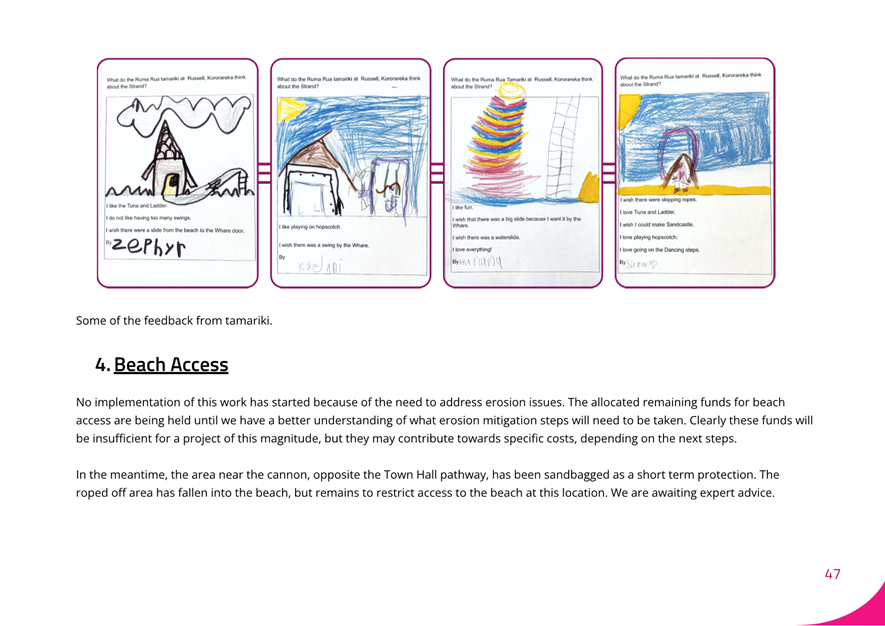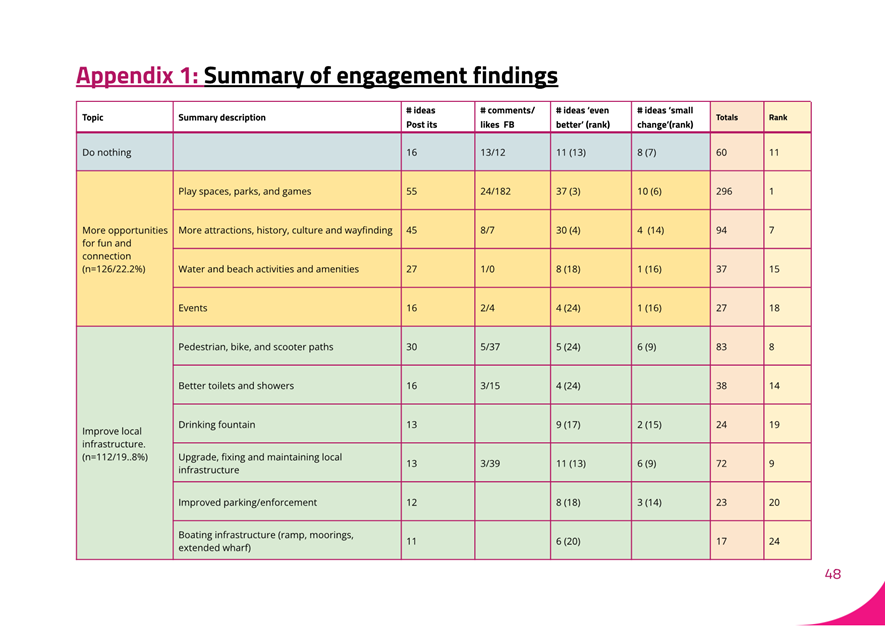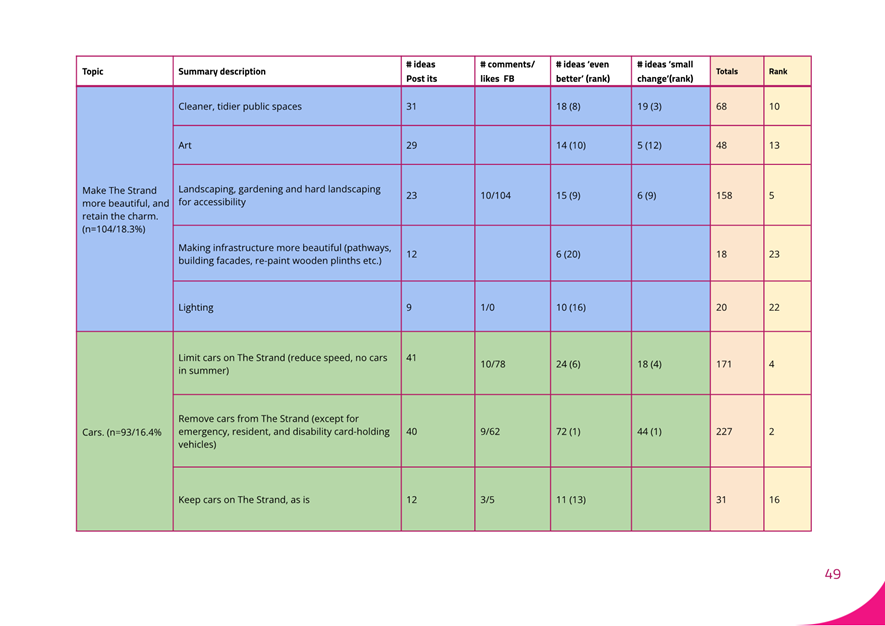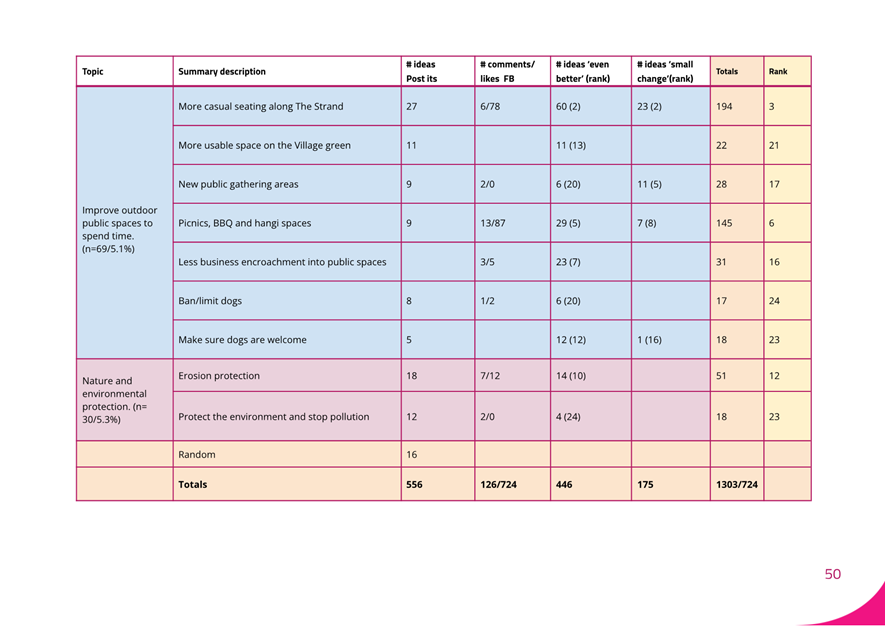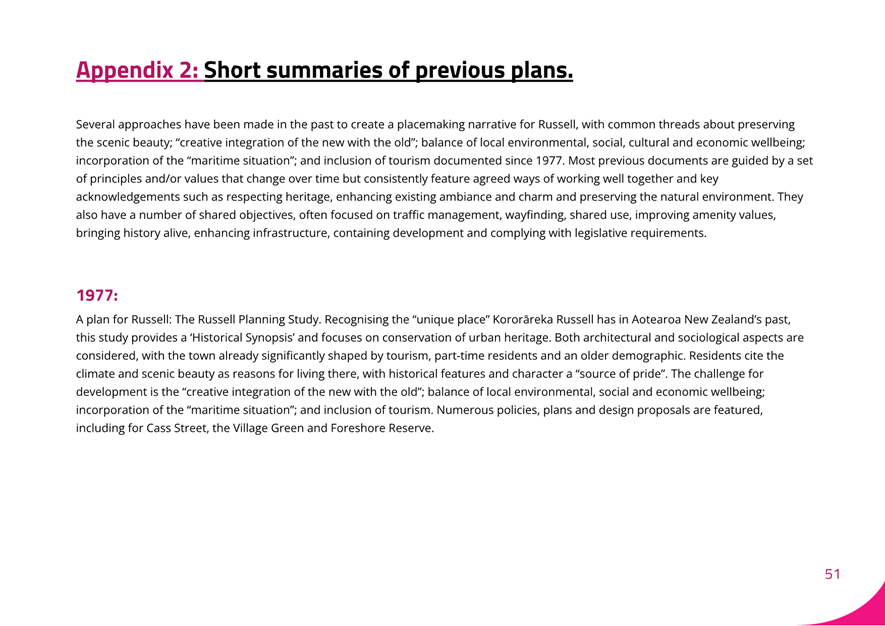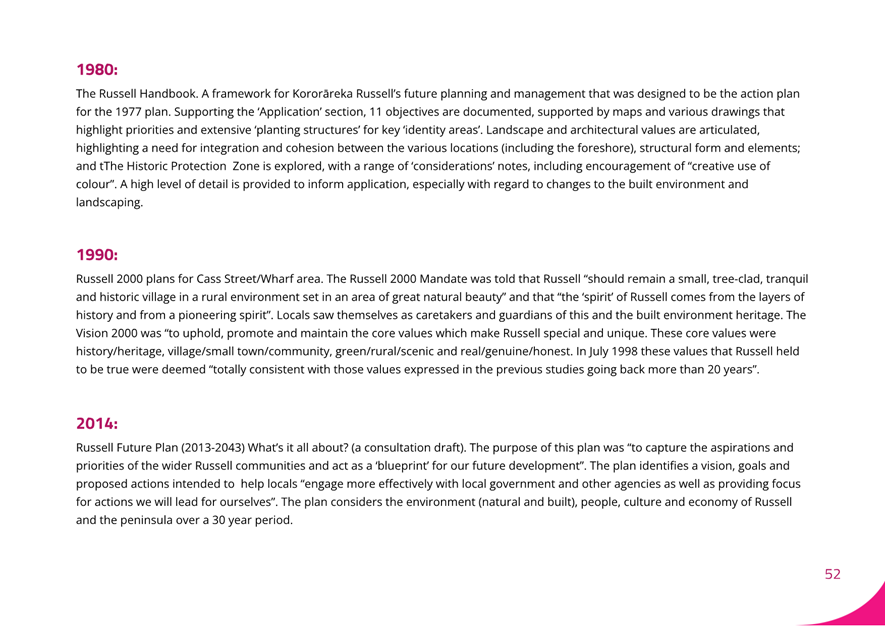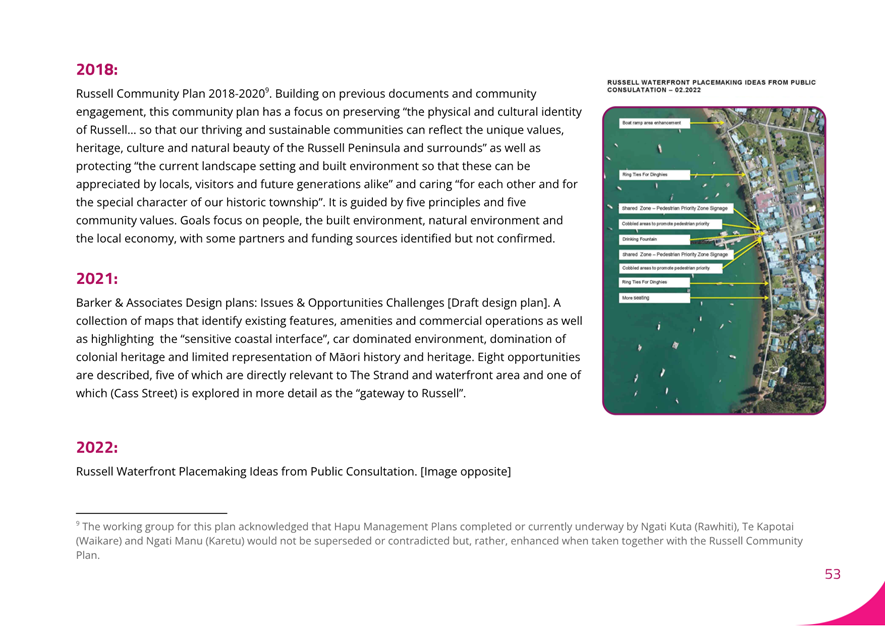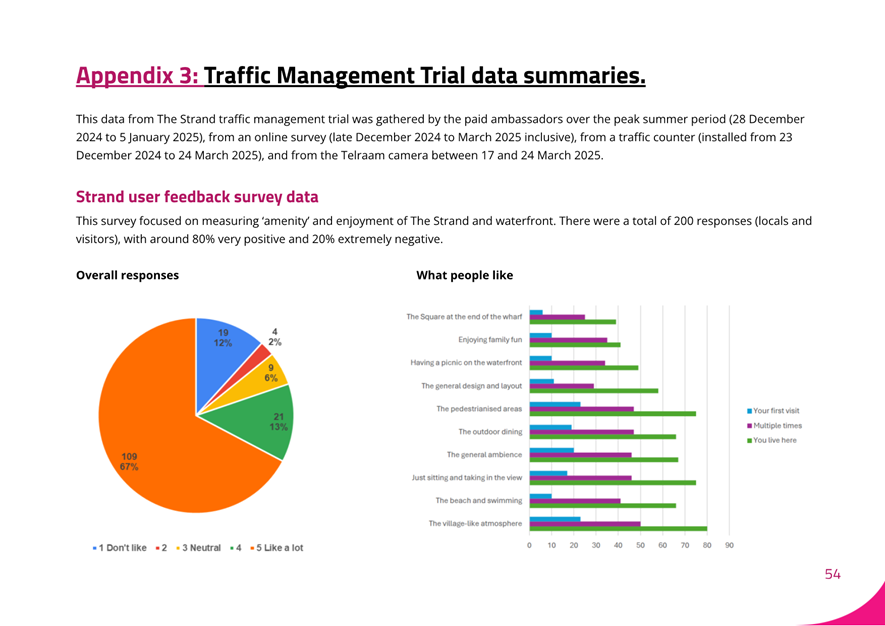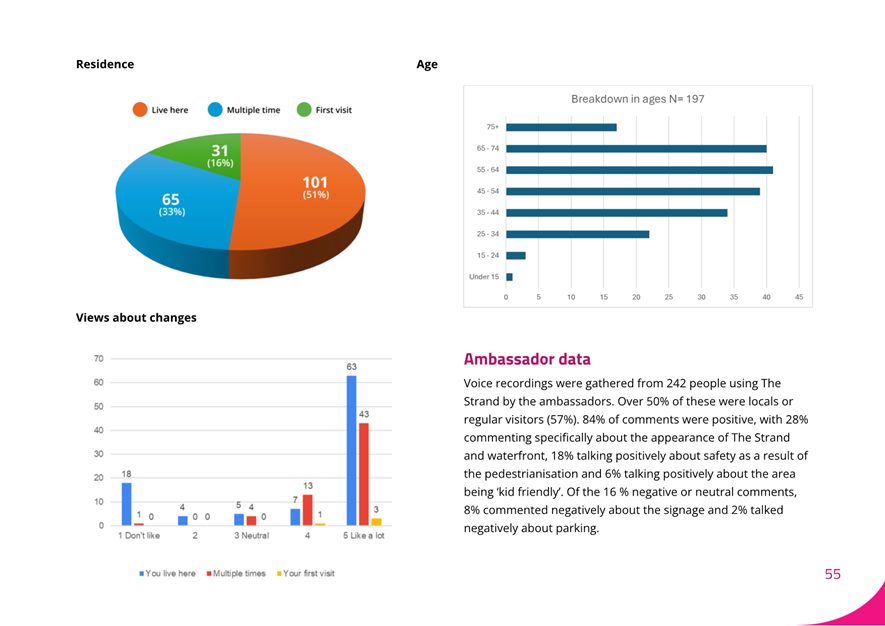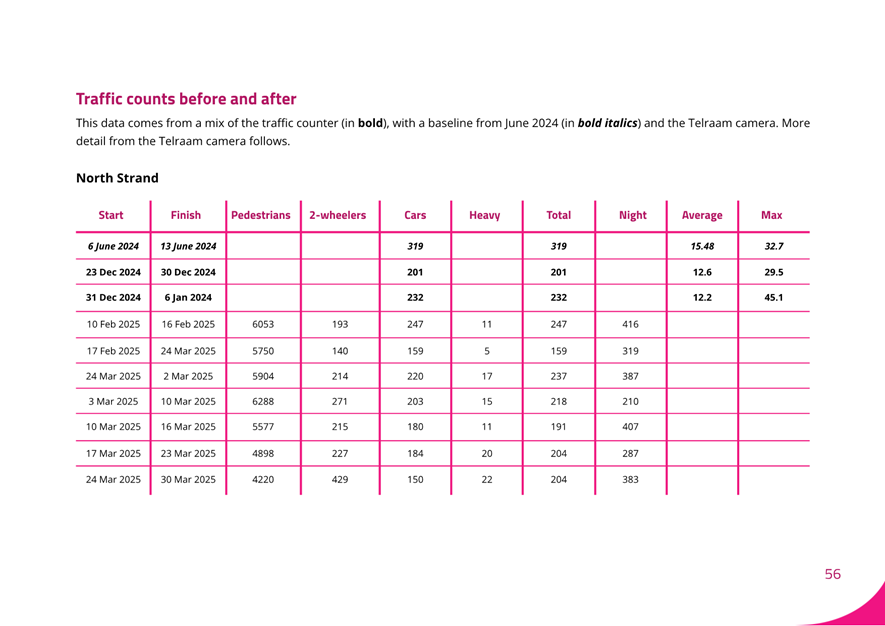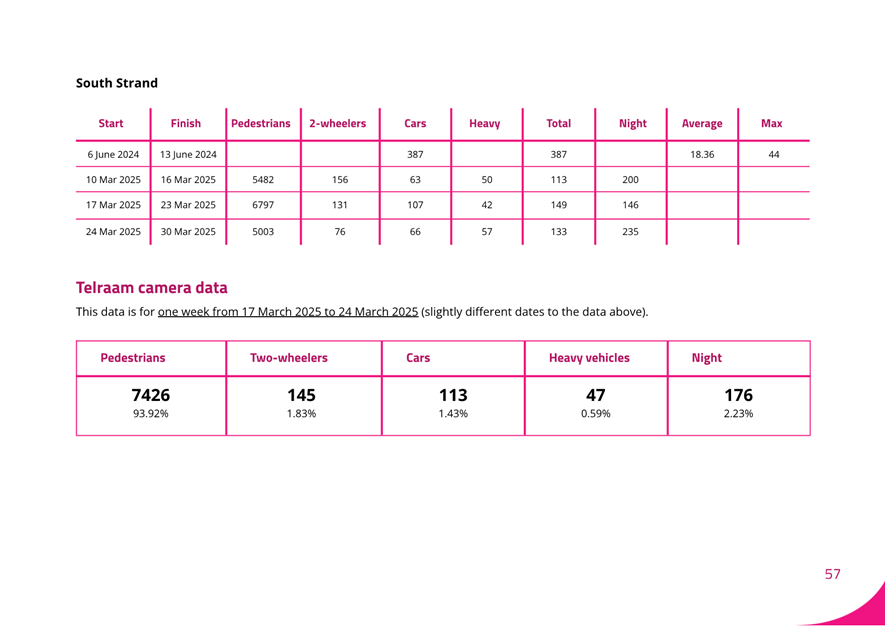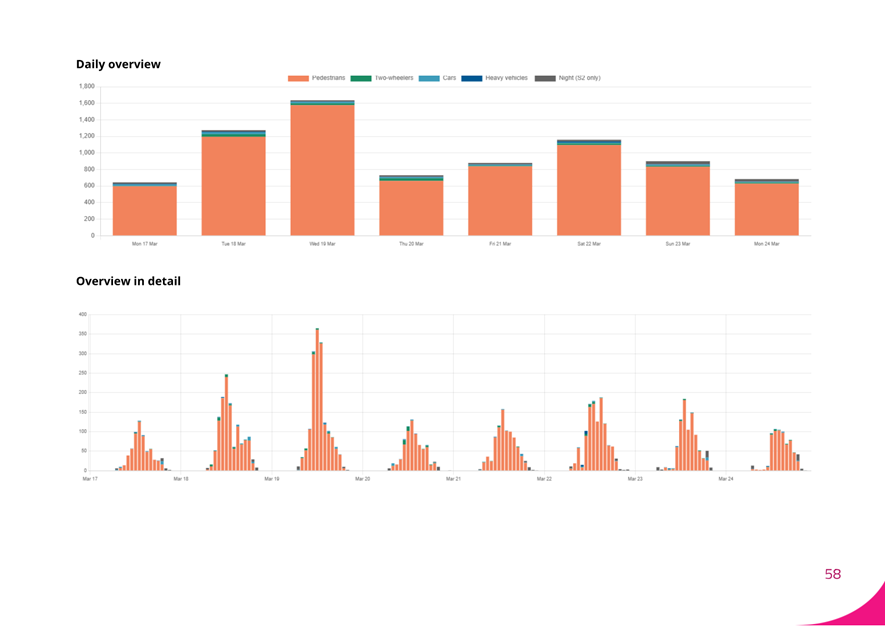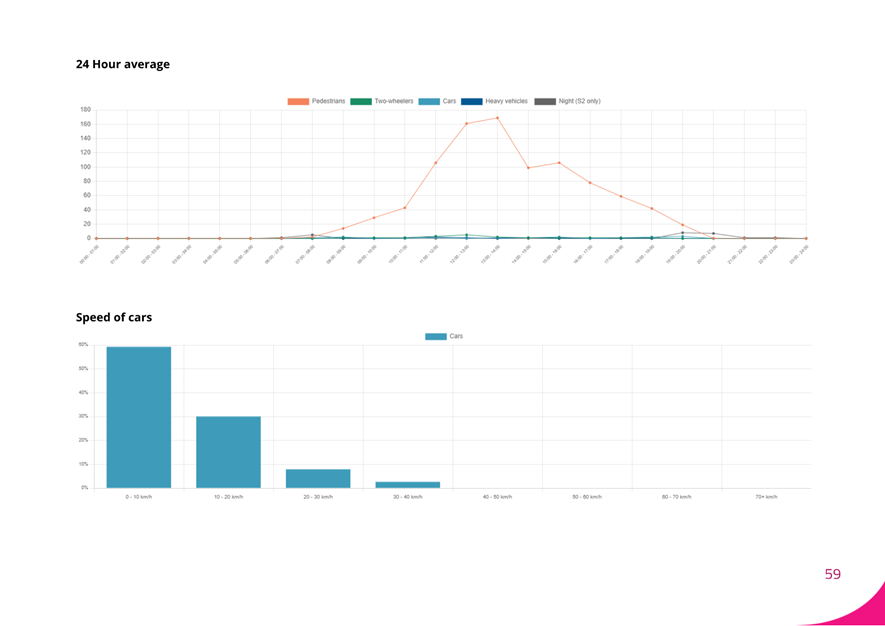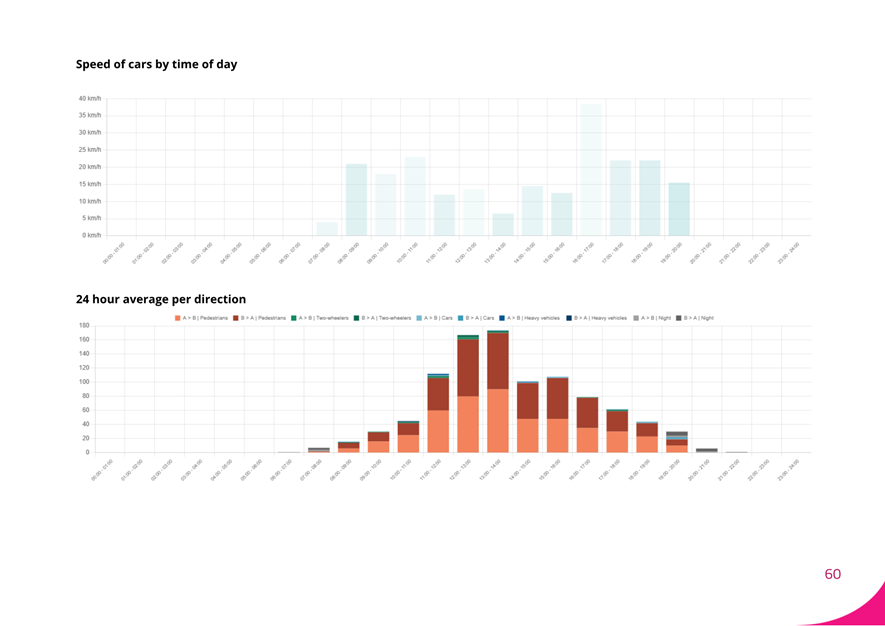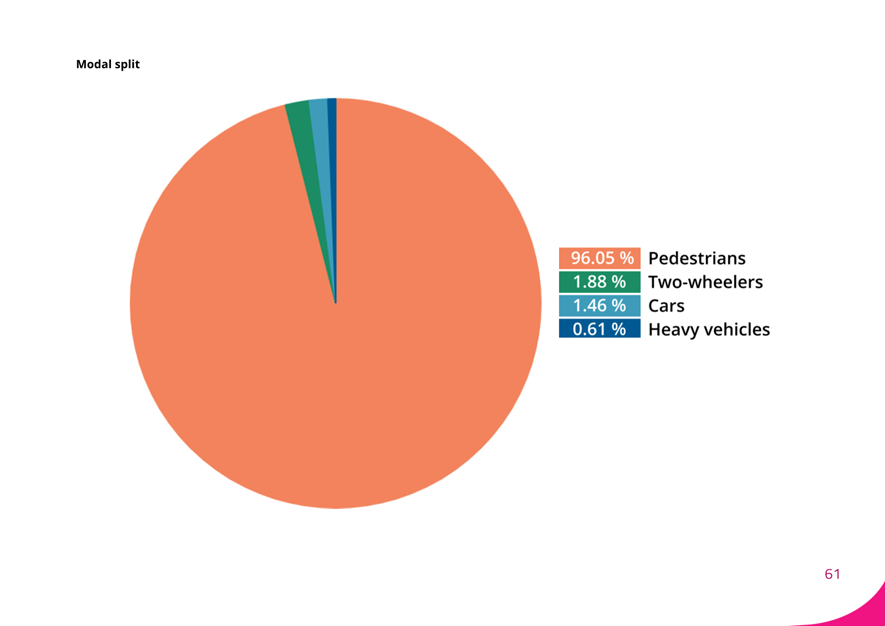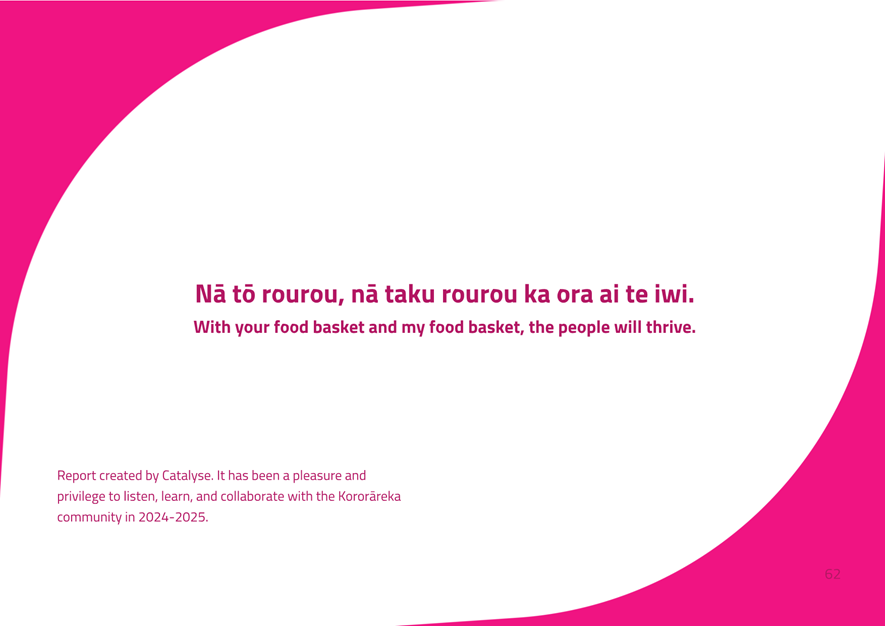7 Ngā
Pūrongo / Reports
7.1 The
Strand, Kororāreka Russell Traffic Trial
File
Number: A5145928
Author: Emma
Manning, Senior Strategic Planner
Authoriser: Ken
MacDonald, Chief Financial Officer
Take Pūrongo / Purpose of the Report
To recommend a permanent solution for after The Strand, Kororāreka Russell Traffic Trial ends on 1 September
2025 to the Bay of Islands-Whangaroa Community Board.
WhakarĀpopoto matua / Executive Summary
· The Bay of Islands-Whangaroa Community Board granted the community
of Kororāreka Russell $100,000 for placemaking in 2022 ($15,000
via Resolution 2022/09 and $85,000 via 2022/56).
· Extensive community engagement throughout 2024 identified 79% of
participants surveyed wanted to change the use of The Strand from a road.
· Under the Land Transport Rule: Streets Layout 2023, Council as the
Road Controlling Authority decided on 12 September 2024 to implement a
six-month trial (Resolution 2024/126).
· The Strand Traffic Management trial commenced on 8 December 2024.
· On 10 April 2025, Council decided to extend the trial to 1 September
2025.
· Staff conducted a four-week consultation ending on Tuesday 27 May
2025 which received 383 submissions which asked submitters what they think
should happen after the trial ends.
· The consultation survey found 33.60% wanted to keep the trial,
33.90% wanted to revert The Strand, and 32.30% wanted all of The Strand to be
pedestrian priority.
· Staff recommend that the trial be made permanent after further
design work based on the following:
o Analysis of the consultation submissions
o Statements from the Project Steering Group and Traffic Management
Group
o Consideration of the existing Parking Bylaw and Mobility Access in
Cass Street
o Consideration of the objectives of the Russell
Historic Township Overlay.
1) TĀhuhu kŌrero / Background
In early 2024, the community with support
from the new FNDC Growth Planning and Placemaking team started the
Kororāreka Russell Placemaking Plan project. This project was initiated in
response to an application for alfresco dining by the Duke of
Marlborough. On 5 August 2021 the Bay of Islands-Whangaroa Community Board
(Community Board) resolved (2021/61), in addition to considering the alfresco dining application, for the ‘community
board members to engage with the Russell community to develop a Placemaking
kaupapa for the Strand, Russell’. As a result, in 2022, the Community
Board granted the Kororāreka Russell community $100,000 for placemaking (Resolution 2022/09 and
2022/56).
To support a new placemaking initiative for
Kororāreka Russell, a Project Steering Group comprising community
representatives was established to partner with Council and lead the
placemaking project. Throughout 2024, the Steering Group led engagement events
which attracted over 1300 ideas to improve the public realm and foreshore of
Kororāreka Russell.
One of the outcomes of the engagement in
2024 was the Kororāreka Russell community wanted to change in the
way people and cars interact along the waterfront. In response, the community were asked via an online survey what they wanted to
change, and the community provided the following feedback:
• All of the
Strand as a pedestrian priority from Pitt Street to Kent Street providing
access for essential vehicles = 45%
• Pedestrian
priority along south of The Strand from Cass Street to Pitt Street with access
for essential vehicles = 19%
• All of the
Strand as a shared space from Pitt Street to Kent Street = 15%
• The Strand
remain as a road = 21%
Based on the above, at its meeting on 15
August 2024 (Resolution 2024/90), the Community Board recommended a six-month
traffic management trial during which the use of The Strand would be changed to
allow essential vehicle access only between Cass Street to Pitt Street (Refer
to the Diagram on Page 4 of Attachment 1).
Under the Land Transport Rule: Streets
Layout 2023, Council is the Road Controlling Authority. Therefore,
subsequently, Council considered the above recommendation at its meeting on 12
September 2024 and agreed to implement the trial (Resolution 2024/126). As a
result, The Strand Traffic Management trial commenced on 8 December 2024.
The Project Steering Group formed a traffic
management sub-committee (Traffic Management Group) to oversee the trial and
report back to the Project Steering Group.
2) matapaki me NgĀ KŌwhiringa /
Discussion and Options
Council Consultation
In accordance with 3.5(b)(i) of the Land
Transport Rule, Council must give the public a reasonable opportunity to
provide feedback on the trial. As a result, staff facilitated a four-week
consultation period from Tuesday 29 April 2025 to Tuesday 27 May 2025.
The consultation included two information
sessions in Kororāreka Russell, promotional video shared on Councils
Facebook and social media, letters and emails sent directly to ratepayers and
occupiers from Tapeka Point across to Rawhiti, including Kāretu
Marae, Waikare (Te Tūruki) Marae, Te Rāwhiti (Omakiwi) Marae,
Kaingahoa (Rāwhiti) Marae and Kororāreka Marae inviting them to
participate in an online survey. The Project Steering Group and the Traffic
Management Group also used their local networks to promote the consultation.
Survey
The central question of the consultation
survey was, “What next for the Strand?” with the below three
options.
· Option 1:
“Keep the current trial layout - Shared space from Seaside Café to
the boat ramp. Pedestrian priority zone from Cass Street to the Marae, with
access for essential vehicles only. 'No Left Turn' sign to remain on Cass
Street.”
· Option 2:
“Remove the trial layout and return The Strand to its original
setup.”
· Option 3:
“Full pedestrian priority zone from the boat ramp to the Marae (not
funded) with access for essential vehicles only.”
Staff also developed concept diagrams for each option to
help the community understand the interconnection and interdependence between
Cass Street and The Strand when voting on a permanent solution (see Attachment
2). What was trialled and what was approved to be trialled deviated slighted.
Please refer to Attachment 3 for a detailed explanation of what was trialled
and the term essential vehicle.
The key statistics from the consultation results are as
follows:
· 383 total
submissions, including 365 survey responses.
· 63% of survey
respondents said their experience of The Strand since the trial began was
either the same or better.
· 93% of survey
respondents identified as fulltime or part time residents.
· 60% of survey
respondents said they visit The Strand daily.
· 65.7% of total
submissions (252 submissions) wanted either all or part of The Strand to be
pedestrian priority with access for essential vehicles.
In addition to the above, the data collected for the survey
questions relating to the to safety, access, signage, and accessibility to the
wharf has been excluded from the report because the data is unreliable due to
the answer options switching between a positive and negative sentiment ranking.
The results of the survey are as follows:
|
|
Keep the current trial layout with
access for essential vehicles only
|
Remove the trial layout and return The
Strand to its original setup
|
Full pedestrian priority zone with
access for essential vehicles only
|
TOTAL
|
|
Online Survey (including any subsequent
email comments)
|
100*
|
92
|
99
|
291
|
|
Hard Copy (including any subsequent
email comments)
|
21
|
36**
|
17
|
74
|
|
Email Submissions (officer assigned
category)
|
8
|
2
|
8
|
18
|
|
TOTAL
|
129
|
130
|
124
|
383
|
|
PERCENTAGE
|
33.60%
|
33.90%
|
32.30%
|
|
|
*16 respondents selected two options.
This figure includes 15 respondents that selected keep the trial and full
pedestrian priority and 1 respondent that selected keep the trial and go back
**7 late hard copy submissions were
received on 4 June 2025 which are not included in these statistics or this
analysis. Inclusion of these late submissions in these statistics would not
have altered FNDC Staff recommendations.
|
Survey Comments
The survey asked respondents whether
their experience of the trial was better or worse during the trial and also
provided a freeform box allowing 150-200 words explaining why their experience
was better or worse. The depth, breadth and specificity of the comments has
been integral in forming this recommendation.
Broadly, the comments align between people whose experience
of the trial was better or worse. The people who had a better experience
referenced the correlation between improved ambiance/atmosphere (181) on the
foreshore and their being less cars (157), resulting in an increased feeling of
safety and enjoyment of the foreshore and the adjacent businesses. Equally
there was strong correlation between comments where users experience of the
changes to Cass Street – including reduced visibility, reduced manoeuvrability,
difficulty parking, congestion, and impeded access to the wharf – meant
that their experience of the trial was negative. Even if they agreed that
having less traffic on the Strand enhanced the foreshore for others, such as
children, visitors and tourists. While the overall sentiment in the comments
reflected the choice for what happens next, the comments raised important
design considerations for any permanent solution which are detailed in
Attachment 4.
Options for a Permanent Solution
Option 1: “Keep the current trial layout - Shared
space from mid-block Cass Street to the boat ramp. Pedestrian priority zone
from Cass Street to the Marae, with access for essential vehicles only. 'No
Left Turn' sign to remain on Cass Street.”
Advantages:
· Supported by the
Project Steering Group (see Attachment 5).
· Supported by the
Traffic Management Group (see Attachment 6).
· The
Transportation Capital Works and Renewals Team has estimated that the cost of
permanently installing roading infrastructure would be between $20,000-$30,000.
There may be additional costs associated with achieving a high-quality design
response, if engagement of a heritage consultant is required.
· Enables residents
and visitors to go to the south of the Strand if they want to enjoy the
foreshore with less traffic which is quieter and with less emissions and feels
safer because there are less cars.
· The trial has
demonstrated that less traffic enhances the atmosphere and ambiance of the
foreshore.
· Less traffic to
the south of the Strand reduces the risk of a collision between a car and a
person or a child.
· Less traffic is
safer for people with limited mobility.
· Ensures tangata
whenua access to the coastal marine area.
Disadvantages:
· The submitters
(30) whose comments indicated that they did not enjoy the trial or who missed
being able to drive down the south of the Strand will not be able to drive down
the south of the Strand unless they are an essential vehicle.
Staff Recommendation: While a permanent solution
needs to be responsive to the concerns raised by the community during the
consultation relating to the functionality of Cass Street and the objectives of
the Kororāreka Russell Township Heritage Overlay, staff recommend
retaining a pedestrian priority with essential vehicle access from Cass Street
to the Marae without a physical barrier because:
1. The
majority of submitters wanted to see either part or all of the foreshore as
pedestrian priority,
2. The
trial demonstrated that reducing traffic on The Strand increased the ambiance
of the foreshore and users felt safer,
3. The
majority of the concerns raised with the trial pertained to design issues which
can be addressed prior installation of a permanent solution,
4. Keeping
the trial will enhance the foreshore as a tourist destination, and
5. Keeping
the trial is in line with the strategic priorities of the Bay of
Islands-Whangaroa Community Board Strategic Plan 2022.
While staff support keeping the trial, it may take some time
for a permanent solution to be installed because there is currently no funding
and further detailed design work is required. In the interim, the planters and
barrel adjacent to Russell Fresh are recommended to be removed as they are
impeding both a legal loading zone and a mobility space.
Also, the Transportation Capital Works and
Renewals Team have advised that the longevity of the temporary planters and
barrels in Cass Street could be up to ten years depending on upkeep. The rocks
and landscaping may not last as long because they are placed on top of the
asphalt and are not fixed in place and can be shifted easily. Note, any
permanent roading infrastructure constructed as part of this option would be
owned and maintained by Council.
Option 2: “Remove the trial layout and return The
Strand to its original setup.”
Advantages:
· Returning The
Strand to its previous form will ensure that users of the wharf will have
unimpeded access to the foreshore.
· Removing the trial
would be the cheapest option, but it would still attract some expense to remove
and dispose of the trial devices and signage currently installed in Cass
Street. The Transportation Capital Works and Renewals Team has
estimated that removing the trial infrastructure would cost $5,000 or less. In
addition, there is no budget provision for any solution in the Transportation Capital Works and Renewals budget presently.
If this option was chosen, funding would need to be allocated from existing
placemaking funding or Council would have to allocate additional funds from a
different budget.
· Would enable all
people to enjoy driving down The Strand.
· The speed limit of
The Strand may be reduced from 30kmh to 10kmh via a separate Council process.
Therefore, in that case, reverting to a road would be less hazardous than it
was before the trial.
· Ensures tangata
whenua access to the coastal marine area.
Disadvantages:
· The trial has
demonstrated a correlation between less traffic and increased ambiance on the
foreshore. This option would increase the number of vehicles using The Strand
which would make The Strand less enjoyable for pedestrians.
Staff Recommendation: Staff do not recommend this
option because extensive community engagement throughout 2024 identified that
79% of survey respondents wanted to change the use of The Strand from a road to
a shared space or to all or part pedestrian priority. Subsequently the trial
confirmed that after experiencing and change of use on the Strand 65.7% of
submitters still wanted all or part of The Strand to be pedestrian priority.
Additionally, the majority of opposition to the trial related to the changes to
Cass Street, not prioritising the use of the Strand for pedestrians.
Option 3: “Full pedestrian priority zone from the
boat ramp to the Marae (not funded) with access for essential vehicles
only.”
Advantages:
· Traffic counts
collected by the Traffic Management Group show there are instances of vehicles
travelling at up to 60kmh along The Strand. A full pedestrian priority option
would provide a physical barrier to prevent speeding vehicles from endangering
pedestrians.
· Full pedestrian
priority would enable people to dine at businesses along the waterfront with
less vehicle noise and exhaust.
· Concerns have been
raised by owners of businesses to the north of the Strand that cars fly past
their businesses and they are worried – because of the speed – that
one of their staff, or patrons or a child could be hit by a car. Full pedestrian
priority would ensure that the businesses and not burdened with increased risk
to their staff because more vehicles are using the north of the Strand now that
they can’t turn left from Cass Street.
· Speed humps have
been suggested to reduce traffic speeds on the Strand. Speed humps are not
supported by the Disabled Persons Assembly New Zealand because they are
difficult to navigate for people with limited mobility.
Disadvantages:
· Reduces tangata
whenua access to the coastal marine area.
· This would be the
most expensive option to implement. The Transportation Capital
Works and Renewals Team has estimated that the cost of installing a
mini-roundabout, bollards, signage and narrowing features would be at least
$250,000.
· Russell Volunteer
Fire Brigade and other emergency services need to have uncompromised access to
the Strand in the event of an emergency, any lowerable bollards would take time
to remove in an emergency.
· The legal mobility
space, bus stop and loading zone in the Parking Bylaw 2022 adjacent to the
wharf would need to be removed and relocated elsewhere.
· This solution
would mean there is nowhere for cars to stop to pick up/drop off passengers to
the passenger ferry at the end of the wharf.
· With a
mini-roundabout, there is nowhere for vehicles to pass other vehicles which are
stopped adjacent to the wharf to restock/services vessels.
Staff Recommendation: Staff developed concept
diagrams for this permanent solution to show the Kororāreka Russell
community that, in order for full pedestrianisation to be achieved, a
mini-roundabout would need to be installed in Cass Street and lowerable
bollards (or similar) installed to prevent access from Cass Street to The
Strand. Staff do not support this option because there is strong opposition in
the community to defining, policing or enforcing the distinction between
essential and non-essential vehicles. Also, between the pre-trial survey and
the post-trial survey, support for this solution decreased by over 10%. While
the comments have not illuminated the reason for this shift, the
mini-roundabout would mean that the shared space next to the wharf that is
currently used like a town square would be lost. Note, any permanent roading
infrastructure constructed as part of this option would be owned and maintained
by Council.
Options for Funding
The Bay of Islands-Whangaroa Community Board identifies in
its Strategic Plan dated July 2022: “Placemaking The Strand Russell.
Finding creative solutions to manage the Strand area the many user groups while
respecting the historic significance of the area.” Therefore, while
the trial was initiated as result of community engagement, pedestrianising the
Strand aligns with the Strategic Priorities of the Bay of Islands-Whangaroa
Community Board.
Option 1: Fund a permanent solution via inclusion in the
Long Term Plan
Advantages: A long term funding strategy ensures there is
time to plan and execute a high-quality responsive design to ensure the
concerns that have been raised throughout the trial by the Kororāreka
Russell community are mitigated in a permanent solution.
Disadvantages: The temporary instillations will degrade over
time and could potentially become a safety hazard or detract from the protected
heritage attributes of the Kororāreka Russell Township.
Staff Recommendation: Staff recommend this option
because roading infrastructure will need to be designed and implemented by
Council’s roading representatives in line with Council’s
obligations as the Road Controlling Authority. Council’s representatives
are therefore best placed to ensure a permanent solution complies with safety
standards and complements Kororāreka Russell’s heritage aesthetic.
Option 2: Fund a permanent
solution via Community Board Grant Funding
Advantages: providing grant funding to start the detailed
design work for a permanent design will be faster and give the community more
control over the final design of the roading solution if they are leading the
engagement with heritage architects and engineers. The Community Board’s
Strategic Plan justifies using grant funding for a permanent solution because
the outcome will both effect and benefit the whole Kororāreka Russell
community and the Ward and District more broadly. Using grant funding as a mechanism
to implement a permanent solution ensures the Community Board have control over
the detail design and can award grants to local providers in line with the
wishes of the Kororāreka Russell community.
Disadvantages: Using grant funding for a permanent solution
may result in less funding being available for grant proposals in other areas
of the Ward. It may result in complexities not having the project managed
by the Transportation Department.
Staff Recommendation: Staff would not discourage the
Community Board from using grant funding to expedite a permanent solution but
note this is not likely to be financially viable within the Community
Board’s allocation for the next financial year. It may also be
challenging for a community board to direct functions that would normally be
managed by the Transport Department.
Next Steps
After the Community Board decide on a permanent solution,
the decision will need to be referred to Council for endorsement as the Road
Controlling Authority in accordance with the Land Transport
Rule: Streets Layout 2023 before any design work can commence toward a
permanent solution. Upon a decision of the Council, if supported, the planters
and barrel adjacent to Russell Fresh are recommend to be removed immediately.
Under the Land Transport Rule: Street
Layouts 2023 a trial period means the two year period from the date of the
installation of the trial, in this case 8 December 2024 to 8 December 2026 (r
1.4(1)). A Road Controlling Authority may end a trial before the two-year trial
period has expired by making a decision on a permanent solution (r 3.9(2)).
After Council has made its decision and before the trial period ends, Council
must notify the public a) when the trial will end (under r 3.8) and tell the
public of the decision/outcome of the trial (under r 3.9(2)).
If Council resolves to make the street
layout changes that were subject of the trial permanent, then Council can keep
installed on the road the street layout changes that were subject to the trial
until a permanent solution can be installed (r 3.11(2)). There is no time limit
for permanent roading infrastructure to be installed. Council is however
required to keep the public informed as to the design and timeline of the
installation of permanent roading infrastructure via, for example, a
website page providing updates to the community on progress.
TAKE TŪTOHUNGA
/ REASON FOR THE RECOMMENDATION
The Kororāreka Russell community are a highly active
community that have championed changing the use of The Strand from a road to
pedestrian priority for the benefit of residents, visitors and tourists. The
trial proved that the foreshore would be better with less traffic and making
the trial permanent subject to further detailed design to Cass Street enables
less traffic on the Strand without requiring physical barriers. Keeping the
trial also ensures the waterfront can be accessed by tangata whenua, businesses
that need to access The Strand, residents with properties on The Strand and
emergency services.
3) PĀnga PŪtea me ngĀ
wĀhanga tahua / Financial Implications and Budgetary Provision
The Transportation Capital Works and
Renewals Team have advised that none of the options for a permanent solution
would likely be able to meet the criteria for New Zealand Transport Agency
(NZTA) subsidy so any works would be at 100% Council share. There is no budget
provision for any solution in the Transportation Capital Works and Renewals
budget presently.
The recommended by staff estimates that the
cost of permanently installing roading infrastructure to make the trial
permanent would be between $20,000-$30,000. There may be additional costs
associated with achieving a high-quality design response if engagement of a
heritage consultant is required. There funds are recommended to come from
a Long Term Plan.
Āpitihanga / Attachments
1. Pre-Trial
Concept 2024 - Option 3 - A5217030 ⇩ 
2. Trial
2025 - The Strand Consultation Diagrams - A5208811 ⇩ 
3. What
was trialled - A5218739 ⇩ 
4. Analysis
of Submission Comments and Recommended Responses - A5218735 ⇩ 
5. Statement
From The Kororāreka Russell Steering Group – Received 27 May 2025 -
A5217055 ⇩ 
6. Statement
From The Kororāreka Russell Traffic Management Group – Received 28
May 2025 - A5217059 ⇩ 
Hōtaka Take Ōkawa / Compliance Schedule:
Full consideration has been given to the provisions of the
Local Government Act 2002 S77 in relation to decision making, in particular:
1. A
Local authority must, in the course of the decision-making process,
a) Seek
to identify all reasonably practicable options for the achievement of the
objective of a decision; and
b) Assess
the options in terms of their advantages and disadvantages; and
c) If
any of the options identified under paragraph (a) involves a significant
decision in relation to land or a body of water, take into account the
relationship of Māori and their culture and traditions with their
ancestral land, water sites, waahi tapu, valued flora and fauna and other
taonga.
2. This
section is subject to Section 79 - Compliance with procedures in relation to
decisions.
|
He Take Ōkawa /
Compliance Requirement
|
Aromatawai Kaimahi /
Staff Assessment
|
|
State the level of significance (high or low) of the
issue or proposal as determined by the Council’s
Significance and Engagement Policy
|
The Kororāreka Russell Historic Township is of
district wide significance and therefore a four-week community consultation
process was conducted to ensure anyone across the district could comment on
what should happen after the trial ends. The matter is of high significance
because the proposal is likely to generate considerable community interest.
|
|
State the relevant Council policies (external or
internal), legislation, and/or community outcomes (as stated in the LTP) that
relate to this decision.
|
Accessibility Policy (2022)
Art and Memorials in Public
Places Policy (2017)
Community Gardens Policy (2013)
Community Grant Policy (2018,
currently under review)
District Plan 2009
Footpath Policy (2016)
Heritage New Zealand Pouhere
Taonga Act 2014
Iwi/Hapu Environmental
Management Plans Policy (2016)
Local Government Act 2002
Long Term Plan (2024-2027)
Parks and Reserves Policy (2022)
Parking Bylaw 2022
Procurement Policy
Resource Management Act 1991
|
|
State whether this issue or proposal has a District wide
relevance and, if not, the ways in which the appropriate Community
Board’s views have been sought.
|
The Kororāreka Russell Historic Township is of
district wide significance and the Community Board have been involved
throughout the process via the appointment of a Project Steering Group led by
a Community Board Member.
|
|
State the
possible implications for Māori and how Māori have been provided
with an opportunity to contribute to decision making if this decision is
significant and relates to land and/or any body of water.
State the
possible implications and how this report aligns with Te Tiriti o Waitangi /
The Treaty of Waitangi.
|
The Project Steering Group engaged widely
during the trial, this included:
- Hapū
representation on the Project Steering Group and the Traffic Management Group
- Direct
invitation to surrounding Maraes in the consultation
- Consideration
of access to water for tangata whenua
|
|
Identify persons likely to be affected by or have an
interest in the matter, and how you have given consideration to their views
or preferences (for example – youth, the aged and those with
disabilities).
|
The engagement identified over fifty local groups and
community groups and five Maraes within surrounding area with an interest in Kororāreka
Russell. In order to ensure a comprehensive and inclusive engagement, there
has been a range of events and methods employed to ensure opportunities for
participation. The consultation identified significant impacts to the use of
the legal mobility space, the recommendation seeks to have this concern
addressed. Also, business owners, property owners who are directly abutting
the roads that are affected, and their concerns have been reflected
throughout the discussion.
|
|
State the financial implications
and where budgetary provisions have been made to support this decision.
|
The Transportation Capital Works and
Renewals Team have advised that none of the options for a permanent solution
would likely be able to meet the criteria for NZTA subsidy so any works would
be at 100% Council share. There is no budget provision for any solution in
the Transportation Capital Works and Renewals budget presently. Funding would
need to be allocated from placemaking funding or Council would have to
allocate additional funds from a different budget.
|
|
Chief Financial Officer review.
|
The Chief Financial Officer has reviewed this report.
|
7.2 Kororāreka
Russell Placemaking Plan
File Number: A5145940
Author: Emma
Manning, Senior Strategic Planner
Authoriser: Ken
MacDonald, Chief Financial Officer
Take Pūrongo / Purpose of the Report
To seek
the Bay of Islands-Whangaroa Community Board’s endorsement of the
Kororāreka Russell Placemaking Plan and its implementation.
WhakarĀpopoto matua / Executive Summary
· The Bay of Islands-Whangaroa Community Board (Community Board)
granted the community of Kororāreka Russell $100,000 for
placemaking in 2022 ($15,000 via Resolution 2022/09 and $85,000 via Resolution
2022/56).
· Extensive community engagement throughout 2024 culminated in eleven
placemaking initiatives documented in the attached Kororāreka Russell
Placemaking Plan (Attachment 1).
· The $100,000 granted placemaking funding was
allocated by the Project Steering Group to implement four initiatives.
· Seven initiatives remain fully unfunded.
· Staff recommend the Community Board endorse the Kororāreka
Russell Placemaking Plan and decide whether to adopt a funding strategy for
implementation.
|
tŪtohunga
/ Recommendation
That
the Community Board:
1. Endorse
the Kororāreka Russell Placemaking Plan and incorporate its initiatives
into the Community Board Strategic Plan,
2. Confirm
that funding granted under Resolutions 2022/09 and 2022/56 can be used
towards the implementation of the initiatives in the Kororāreka Russell
Placemaking Plan, and
3. Approve
the remaining funding be paid to Far North Holdings Limited for the
implementation of the Kororāreka Russell Placemaking Plan at the
direction of the Community Board or their nominated representative.
|
1)
TĀhuhu kŌrero / Background
The Kororāreka
Russell Placemaking Plan project was initiated in response to
an application for alfresco dining on 5 August 2021. The Bay of
Islands-Whangaro Community Board (Community Board) resolved (2021/61), in
addition to considering the alfresco dining application from the Duke of Marlborough, for ‘community board
members to engage with the Russell community to develop a Placemaking kaupapa
for the Strand, Russell’. As a result, in 2022, the Bay of Islands
Whangaroa Community Board (BOIWCB) granted the community of Kororāreka
Russell a total of $100,000 for
placemaking.
The
Kororāreka Russell community have been developing plans for improvements
to the waterfront since 1970s. These initiatives are detailed in the attached Kororāreka
Russell Placemaking Plan (Attachment 1).
In 2024 it was agreed that the
development of a community led placemaking plan for Kororāreka
Russell supported by the new FNDC (Far North District Council) Growth
Planning and Placemaking Team would be a good opportunity to test the
“best practice guide developed for creating placemaking plans” and
also enable the community board grant to be used to implement initiatives
rather than only design.
To support this
new placemaking initiative for Kororāreka Russell, a Steering Group
comprising community representatives was established to partner with FNDC staff
and undertake a placemaking project. Throughout 2024, the Steering Group
championed engagement events seeking views from the community about what is
important to them, and to describe and prioritise placemaking outcomes on the
Kororāreka Russell foreshore including:
· E-newsletter, social media and website,
· Pop-up shop in Russell 24 April 2024 to 3 May 2024 resulted
in 1300 ideas,
· Public activation weekend 15 June 2024 to 16 June 2024
resulted in 880 submissions, and
· Online survey and vote via the ‘Russell
Noticeboard’ Facebook group resulted in 456 responses received.
As a result of
the distillation of ideas throughout the engagement phase, the Steering Group
identified the following eleven improvements to the foreshore to be progressed
for implementation:
Short term:
· The Strand traffic management trial (6 months)
· Adding more seats along The Strand
· A play trail along The Strand
· Natural steps with rails for beach access
Medium term:
· Additional
picnic tables and rubbish bins
· Additional
pontoon with water play feature
· Commission
a landscape plan for the Village Green
· Explore
options for drinking fountain
Longer term:
· Review
signage and commission new signage
· Identify
stories and how to tell them
· Explore
options for BBQ/Hangi area
Due to the availability of
funding, after the engagement phase was complete, the Steering Group decided to
proceed to implement the four short term projects. For completeness, these four
projects which have begun to be implemented, have been included in the Kororāreka
Russell Placemaking Plan as they may require more funding to be fully realised.
The
$100,00 Community funding has been allocated as follows:
· Initial
placemaking report (Barkers and Associates) $7,500
· The
Strand traffic management trial six months $40,000
· Adding
more seats along The Strand $25,000
· A
play trail along The Strand $7,500
· Natural
steps with rails for beach access $20,000
In
order to implement the above initiatives, the Steering Group appointed four
sub-committees with local volunteers to oversee and report back to the Steering
Group on their progress as follows:
· The
Strand traffic management trial six months - traffic management trial currently
being conducted by FNDC staff,
· Adding
more seats along The Strand - the seats are close to installation,
· A
play trail along The Strand - the play trail has been completed, and
· Natural
steps with rails for beach access - beach access is progressing slowing due to
issues with heritage and beach erosion.
A traffic
management trial is required to be conducted by FNDC staff for any change to
the function of a road. At its meeting on 15 August 2025
(Resolution 2024/90), the Community Board recommended to Council a six-month
trial. Subsequently, Council at its meeting on 12 September 2024 agreed to
implement the trial (Resolution 2024/126). As a result, the trial commenced on
8 December 2024 and will end on 1 September 2025 (an extension was obtained). A
separate agenda item at the June Community Board meeting is seeking a
recommendation from the Community Board as to what should happen after
the trail is concluded.
2) matapaki me NgĀ KŌwhiringa /
Discussion and Options
Funding and Far North
Holdings Limited
Since 2022 when
the funding was allocated, the Steering Group established in 2024 progressed to
start implementing the four priority initiatives. However, the original
decisions approved the funding to be spent on detailed design work and
concept drawings as follows:
· 2022/56: “That the Community Board commits
$85,000 from its Placemaking Fund for 2021-22 to detailed design work at The
Strand, Russell.”
· 2022/09: “that,
as a result of consultation with the Russell Community thus far, the Community
Board approve the cost of procurement up to $15000 for concept drawings for The
Strand, Russell, from the Bay of Islands - Whangaroa Community Board
placemaking funds.”
Because Council created a Growth
Planning and Placemaking team in 2023, there was some overlap between what FNDC
staff were able to complete since the original funding was allocated and
therefore not all these funds were needed for detailed design work and concept
drawings, and most of the funding has therefore been spent on implementation.
While endorsement was given, no additional Community Board resolution was
passed to reflect the change in how the grant could be spent and staff are now
seeking that to be rectified. Additionally, any unspent funding will not role
over to the next financial year, as has been the case in previous years, if not
spent by 30 June 2025 due to changes in auditing regulations. Therefore, the
unspent funds need to be transferred to an external party such as Far North
Holdings Limited (FNH), or they will be lost.
Option 1: Accept the Funding
Recommendation
Advantages: the recommendation
allows for all remaining funds to be paid to FNH for the implementation of the Kororāreka Russell Placemaking Plan which could be used
for beach access which was the initiative which received the most support from
the community throughout the engagement in 2024.
Disadvantages: the Community Board would not be able to reallocate the remaining
funding to other grant applications being considered before the end of this
financial year.
Staff Recommendation: Staff
recommend this option because the Kororāreka Russell
Placemaking Plan has a high level of community support and if the
funding is not spent by 30 June 2025 the funding will be lost and there is not
enough time between now and the end of the financial year for any other
placemaking projects to be scoped.
Option 2: Reject the Funding
Recommendation
Advantages: the Community
Board would be able to provide savings by not spending their full budget
allocation or putting this funding towards achieving a different strategic
priority.
Disadvantages: not paying this
funding to FNH would mean that the Community Board would lose
the funding because there is not enough time between now and the end of the
financial year to grant this funding to another party for a different
project.
Staff Recommendation: Staff
do not recommend this option. If the funding is not paid to FNH before the end
of the financial year, the Community Board will lose
the opportunity to use this funding.
Kororāreka Russell Placemaking Plan
The engagement led by the Steering
Group throughout 2024 identified eleven improvements to the Kororāreka
Russell foreshore that were supported by the people who participated in the
engagement. Seven of these initiatives however are not costed and there has
been no investigation into the viability of the implementation of these
initiatives. Also, some of the initiatives proposed involve creating FNDC owned
assets that may overlap with upgrades that would ordinarily be carried out by
FNDC’s Property and Facilities Management Department. Therefore, as some
of these initiatives relate to providing more civil amenities on FNDC Land,
others relate to works in the coastal marine area that would ordinarily be
undertaken by FNH, and some are related to capturing the history and
significance of Russell which require leadership and input from the community,
a mixed funding strategy may be most appropriate. Nonetheless, including all
the initiatives in the Community Board’s Strategic Plan provides clarity
to the Kororāreka Russell that these initiatives are supported by the Community
Board and certainty for anyone wishing to invest in developing these concepts.
If the Community Board agree with
the community that these initiatives will improve the public realm in
Kororāreka Russell, the following options are available to the Community
Board to fund and deliver some or all of the initiatives:
a) Implemented
by Council as part of the Long Term Plan,
b) Implemented
by the Kororāreka Russell community using Community Board grant funding,
or
c) Implemented
by the Kororāreka Russell community using private or volunteer funding
sources.
Option
1: Endorse the Kororāreka Russell Placemaking Plan and include its
initiatives in the Community Board’s Strategic Plan without a funding
strategy
Advantages: The Community Board
may decide that it does not want to utilise its resources for the
implementation of these projects because it has other strategic properties and
need to use its funding resources for a different purpose. Endorsing the
Kororāreka Russell Placemaking Plan will affirm the wishes of the
Kororāreka Russell community to implement these improvements to the
Kororāreka Russell foreshore. Including these initiatives in the Community
Board’s Strategic Plan formalises the support from the Board.
Disadvantages: The community has
expressed their wishes to be involved in implementation and this option could
lead to outcomes which do not reflect the needs of the various vested
interested in Russell.
Staff Recommendation: Staff
recommend the Community Board endorse the Kororāreka Russell Placemaking
Plan but that, because the initiatives are not costed, further investigation
into the viability of each initiative occur before the Community Board decide
how to implement each of the supported initiatives.
Option
2: Endorse the Kororāreka Russell Placemaking Plan and include its
initiatives in the Community Board’s Strategic Plan with a funding
strategy
Advantages: Implementation by FNDC
staff where appropriate will ensure safety standards and compliance with
regulatory requirements. Using grant funding where appropriate ensures that the
Community Board have control over assessing the detailed design of assets to be
vested in Council and award grants to local providers in line with the endorsed
placemaking plan and its vision for Russell.
Disadvantages:
Through the 2024 engagement findings, the community indicated a preference to
be involved in and drive the implementation of the initiatives and be involved
in detailed design. Conversely, using grant funding for implementation of
multiple projects may result in less funding available for grant funding to be
allocated for improvements to the public realm in other areas of the Ward.
Also, delegating implementation to external providers with no control over the
design or implementation is high risk and could lead to division within the
community or assets which do not comply with FNDC standards and result in a
high-cost burden to ratepayers to maintain long term.
Staff Recommendation: using
a combination of Long Term Plan (LTP), grant funding and private funding
provides the greatest flexibility to Council and enables the Community Board to
decide in the future which is the best method of funding to implement the
placemaking plan and whether the Community Board wants control over how any of
the initiatives are implemented (e.g. grant). Staff recommend the Community
Board endorse the Kororāreka Russell Placemaking Plan but Council support
would need to be sought if the Community Board wanted to seek Long Term Plan
(LTP) funding for some or all of the initiatives.
Example of a mixed funding strategy:
Long Term Plan to be
implemented by FNDC
o Additional
picnic tables and rubbish bins
o Explore
options for drinking fountain
o Explore
options for BBQ/Hangi area
Grant Funding to be implemented by the community
o Commission
a landscape plan for the Village Green
o Review
signage and commission new signage
o Identify
stories and how to tell them
Private
or Volunteer Funding Sources to be implemented by Far North Holdings Ltd
o Additional
pontoon with water play feature
Option
3: Not endorse the Kororāreka Russell Placemaking Plan
Advantages:
The Community Board may decide that it does not want to utilise its resources
for the implementation of these projects because it has other strategic
properties and needs to utilise its resources for a different purpose.
Disadvantages:
The Kororāreka Russell community have invested heavily in participating in
this engagement process and believe the initiatives proposed for endorsement
will benefit this community and improve the Kororāreka Russell foreshore.
Staff
Recommendation: Staff do not recommend this option. The placemaking process
was community led, and the members of the Kororāreka Russell community
want to see these initiatives implemented.
TAKE
TŪTOHUNGA / REASON FOR THE RECOMMENDATION
The Kororāreka Russell
community have participated in a community driven engagement process to
identify initiatives that would improve the Kororāreka Russell foreshore.
Given that the projects identified are located on publicly land owned by FNDC, and
any assets created would be vested in FNDC and maintained by FNDC, it is
appropriate for some or all of the projects to be funded by ratepayers.
Implications and Budgetary Provision
The $100,000 budget allocation for placemaking from the Community
Board has been fully allocated or spent (Resolutions 2022/09
and 2022/57). Any future works associated with implementation of the
initiatives in the Kororāreka Russell Placemaking Plan are
currently unfunded (expect for beach access). The seven unfunded initiatives
recommended for endorsement by the Community Board are not costed and some of
these initiatives may overlap with renewals carried out by FNDC’s
Property and Facilities Management Department.
Āpitihanga
/ Attachments
1. Kororāreka
Russell Placemaking Plan - A5220772 ⇩

Hōtaka
Take Ōkawa / Compliance Schedule:
Full
consideration has been given to the provisions of the Local Government Act 2002
S77 in relation to decision making, in particular:
1. A
Local authority must, in the course of the decision-making process,
a) Seek
to identify all reasonably practicable options for the achievement of the
objective of a decision; and
b) Assess
the options in terms of their advantages and disadvantages; and
c) If
any of the options identified under paragraph (a) involves a significant
decision in relation to land or a body of water, take into account the
relationship of Māori and their culture and traditions with their
ancestral land, water sites, waahi tapu, valued flora and fauna and other
taonga.
2. This
section is subject to Section 79 - Compliance with procedures in relation to
decisions.
|
He Take Ōkawa /
Compliance Requirement
|
Aromatawai Kaimahi /
Staff Assessment
|
|
State the level of
significance (high or low) of the issue or proposal as determined by the Council’s
Significance and Engagement Policy
|
While Kororāreka Russell
Historic Township is of District wide significance, the minor initiatives
proposed by the community will not have a major impact on the significance of
Russell. Also, due to the extensive engagement process which received over
1300 responses, the community have already provided their feedback on these
proposals throughout the refinement built into the engagement process. Also,
the Strand Traffic Management Trial is being considered separately to the Kororāreka
Russell Placemaking Plan, and there was a four-week public consultation
process for the community to comment on what should happen after the trial
ends.
|
|
State the relevant Council
policies (external or internal), legislation, and/or community outcomes (as
stated in the LTP) that relate to this decision.
|
Accessibility
Policy (2022)
Art
and Memorials in Public Places Policy (2017)
Community
Gardens Policy (2013)
Community
Grant Policy (2018, currently under review)
District
Plan 2009
Parks
and Reserves Policy (2022)
Footpath
Policy (2016)
Iwi/Hapu
Environmental Management Plans Policy (2016)
Public
Toilets Policy (2011)
Procurement
Policy
Street
Lighting Policy (2014)
Long
Term Plan (2024-2027)
|
|
State whether this issue
or proposal has a District wide relevance and, if not, the ways in which the
appropriate Community Board’s views have been sought.
|
While Kororāreka Russell
Historic Township is of District wide significance, the minor initiatives
proposed by the community will not have a major impact on the historic
significance of Russell and any changes would need to comply with the
objectives of the Heritage Overlay and the requirements of Heritage New
Zealand.
|
|
State the possible implications for Māori
and how Māori have been provided with an opportunity to contribute to
decision making if this decision is significant and relates to land and/or
any body of water.
State the possible implications and how this
report aligns with Te Tiriti o Waitangi / The Treaty of Waitangi.
|
The Steering Group engaged widely throughout the engagement phase,
this included:
- Hapū
representation on the Steering Group
- Engagement
at the Kororāreka Marae
- Inclusions
of Māori histories within
the Kororāreka Russell Placemaking Plan
|
|
Identify persons likely to
be affected by or have an interest in the matter, and how you have given
consideration to their views or preferences (for example – youth, the
aged and those with disabilities).
|
The engagement identified
over fifty local groups and community groups and five Maraes within
surrounding area with an interest in Kororāreka Russell. In order to
ensure a comprehensive and inclusive engagement, there has been a range of
events and methods employed to ensure opportunities for participation. In
addition, the Steering Group and the Sub-Committees are made up of a diverse
representation across the stakeholder groups, disability advocacy and Hapū
in order to ensure a diverse range of views and opinions.
|
|
State the financial
implications and where budgetary provisions have been made to support this
decision.
|
The seven unfunded
initiatives recommended for endorsement by the Community Board are not costed
and some of these initiatives may overlap with renewals carried out by
FNDC’s Property and Facilities Management Department. Additional
funds are also required to fully implement some of the four initiatives
already being worked on.
|
|
Chief Financial Officer
review.
|
The Chief Financial
Officer has reviewed this report.
|




































